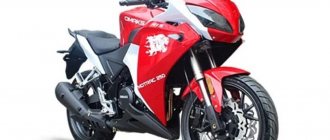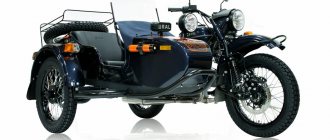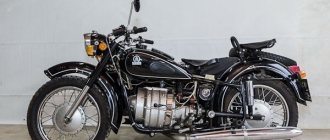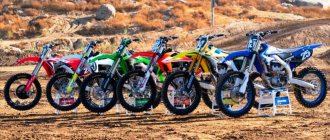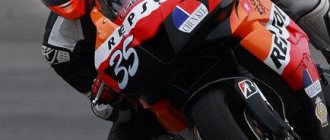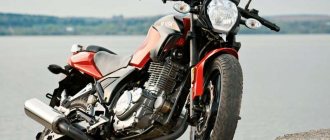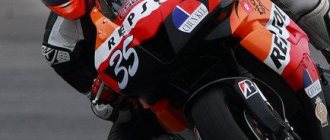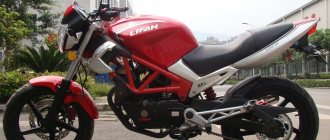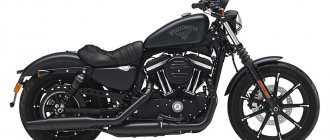Obedient and at the same time playful;
stylish but budget friendly; fast, but safe - the requirements for the first bike can contradict each other. And if the choice has been delayed, and the garage is still empty, you should pay attention to 400 cc motorcycles. Why are they better than their larger cubic-sized counterparts?
- Price. Let's put this indicative first place, because it is by price that we all filter products in any catalogues. Considering that you can take used equipment for training, and at the Japanese auction it will be without mileage in the Russian Federation, the choice in favor of a used “Japanese” is quite obvious.
- Weight. The first trips are also the first falls. The bike, which weighs a maximum of 170 kg, will not cause unnecessary inconvenience both when driving and in the process of lifting iron.
- Character. Yes, motorcycles have their own character, and the 400 models are distinguished by a fairly docile disposition. They do not provoke heroic deeds, but they also give 600cc a head start, accelerating to 200 km/h. quite capable.
- Appearance. The vast majority of four hundred configurations are manufactured by Japanese companies that know a lot not only about technical equipment, but also about creating an attractive, streamlined design.
Brief information
400 cc motorcycles began to be produced in Japan for the domestic market due to taxation regulations. Their power is no more than 53 hp. Later they gained recognition outside the country due to their low cost and ease of operation. Some Chinese factories have made attempts to repeat the success. However, Japanese bikes command complete trust from the public and remain beyond competition.
About popularity
Due to the fact that for a relatively low price you can become the owner of a good device, 400 cc motorcycles have been and remain popular in Russia and the former Soviet Union. Old age does not bother anyone, because manufacturing countries monitor the quality of manufactured equipment. In the case of Japan, 400 cc motorcycles are completely intended exclusively for the domestic market. This is due to the peculiarities of taxation. For example, the Yamaha SR 400 motorcycle was first released in 1978 in two versions: 400 and 500 cc, for the domestic market and for export, respectively. The difference between the two motorcycles, in addition to the cubic capacity, was also in the piston stroke.
But it is impossible to find an old Chinese motorcycle of 400 cc: in this country, two-wheeled vehicles with an engine capacity of more than 250 cm3 are prohibited, and Chinese manufacturers produce large cubic capacity exclusively for export. 400 cc Chinese devices began to appear on the wave of popularity among motorcyclists, especially beginners, of this engine size.
Honda CBR400RR (1990)
In 1990, an updated version of the CBR400RR model was released. The motorcycle had a standard fork, an aluminum frame and a reinforced aluminum swingarm, that is, everything that large sportbikes had, but in smaller sizes.
The modern lightweight frame has been designed to withstand heavy loads. The motorcycle's low weight and low seat also made it accessible to women. The most impressive feature of the new bike is the 14,500 rpm redline. However, maximum power is released at 13,000 rpm and amounts to 53 horsepower.
It should be noted that this is 6 horsepower less than in the original version of the motorcycle. Maximum torque is achieved at 10,000 rpm and is 39 Nm. The engine of the model is a 4-stroke 4-cylinder with two camshafts in the cylinder head and liquid cooling. Its working volume was 399 cubic meters. cm. The cylinder diameter was 55 mm and the piston stroke was 42 mm. The engine operated with a compression ratio of 11.3:1.
Fuel was supplied by four 26 mm constant vacuum carburetors. The maximum speed that the motorcycle was capable of reaching was 175 km/h. It had excellent handling thanks to the new adjustable telescopic fork and Showa rear swingarm suspension with adjustable gas-oil shock absorber.
Why they are loved
Apart from the price, 400cc bikes have one more feature. This is the appearance. As mentioned above, Japanese models of this volume were produced mainly for the domestic market of the country, and many models have modifications with this volume, for example, the same Honda Bros was also produced as a 650 cc. Low gasoline consumption (from 4 liters per 100 km when driving on the highway, depending on weather conditions and speed) will allow you to learn to drive without spending too much on fuel. But another important plus is the weight. 400cc motorcycles weigh on average 150-180 kg. There are no motorcyclists who do not fall, therefore (especially for girls), you need to ride a motorcycle that a person is able to lift from the road. In addition, there are times when you need to roll the bike (this is not always a breakdown, sometimes you can, for example, “bypass” a traffic jam).
Photo gallery
As stated earlier, the Honda CB 400 motorcycle was released in 1975. Over the years, the appearance has changed several times. Looking at the first models and the more modern ones, it’s hard to say with confidence that this is the same motorcycle model. We bring to your attention a small selection of photos of Honda SB 400 from different years of production.
Sources
- https://themoto.net/moto/yaponskie/honda/cb-400.html
- https://motoli.ru/51-honda-cbr-400-cbr400rr.html
- https://chtocar.ru/moto/honda-moto/honda-cbr-400-rr.html
- https://moto.drom.ru/sale/+/Honda+CBR+400/
- https://www.cbr400rr.ru/articles/tehnicheskie_harakteristiki_cbr400rr.html
- https://moto.drom.ru/sale/+/Honda+CBR+400RR/?motoCondition%5B%5D=yes&motoDriveCondition%5B%5D=yes&query=Honda+CBR+400RR%2C+%D8%E8%ED%FB
- https://motoking.ru/bikes/moto/1703/CBR400RR_1990
Previous entry Motorcycle repair and maintenance
Next entry All-wheel drive motorcycle Ural. Why is it worth buying a Ural Gear Up motorcycle?
Ideal for beginners
A sane person would never choose a motorcycle with a large cubic capacity as his first “horse”. This technique not only accelerates very, very quickly (1-2.8 seconds to one hundred kilometers for a 600 cc bike), but also has sharp traction and, of course, excellent brakes. It is worth adding to this that at speed any maneuver must be precisely measured, so among beginners on powerful motorcycles it is not uncommon to fall due to loss of control or due to “overdoing the brakes.”
400cc motorcycles are ideal for beginners. Someone will say that such a volume is small, you will quickly get bored and want something bigger, and they will be wrong, because a 400 cc machine can easily “make” any car and accelerates to two hundred kilometers per hour. But in racing, the skill of the pilot is more important than the power of the engine. But even if a novice motorcyclist sensibly decides not to ride his 600 until he gets comfortable with the controls, nothing insures him against various incidents on the road, where his smart head must also have the right reflexes that will protect him from serious injuries. Without the skills to unlock the potential of the 400cc, is there any point in going for something bigger?
Enduro and motards
For the enduro class, 400cc is a serious cubic capacity and is by no means intended for beginners. Many experienced lovers of off-road riding opt for 250cc models, which are less heavy and capable of cheerfully mischief in the forest or in the field. Motards in this regard differ from them only in the place of operation - in the city instead of off-road.
Examples
- Honda XR400 . A legendary motorcycle with absolutely deserved fame. It seems that it can only be broken intentionally. It was produced in two versions, motard and enduro.
- Suzuki DR-Z400 . A direct analogue and competitor, it also had several modifications.
- Yamaha WR400F . Powerful hard enduro for experienced off-road conquerors. Not suitable for beginners due to its significant mass and explosive nature.
State of the art
400cc Japanese motorcycles are mostly oldies, like the Honda Bros 400, a model with a cool, aggressive design and a twin-cylinder V-twin engine, produced from 1988 to 1992. Thus, the Japanese “four hundred” may already be well over twenty, and with proper care the equipment can last longer, but who can guarantee that the former owner took good care of his bike? There are also relatively new models, for example, the Honda CB400SS, released in 2005, but buying used equipment is always a kind of lottery: it is almost never possible to find out what the mileage is, what circle the odometer is on, how many owners there were and how the device was serviced. Many careless drivers do not consider it necessary to properly monitor their equipment, knowing that they will sell it in a couple of seasons, so if you do not understand motorcycle equipment, you need to go with a mechanic for an inspection - many services provide such a service for a small fee, or at least Take an experienced motorcyclist friend with you.
Road motorcycles
The most extensive category. It can include both old “Japanese” and modern motorcycles from different countries. It is in this direction that novice motorcyclists on a limited budget should look.
Examples
- Honda CB400SF . The most popular motorcycle in Russia! It is inexpensive, there are plenty of spare parts, and it drives very cheerfully. Thanks to his flexible character, he earned the reputation of “the best study desk” of all times.
- Kawasaki ER-4N . A lightweight version of the ER-5N, modern and technologically advanced.
- Honda CB400SS . Vintage bike in retro style. For fans of antiquity. Simple as a brick and just as reliable.
- Yamaha XJR400 . A direct competitor to the Honda CB 400, similar in price and characteristics, like a twin brother.
- Suzuki SV400 . It was produced on the same base as the SV650, and was distinguished by good qualities and a unique L-shaped engine with a perky character.
- Bajaj Dominar 400 . An Indian bike developed in collaboration with the Austrian company KTM. Inexpensive, cute and surprisingly reliable.
- KTM Duke 390 . An option for those who don’t mind paying about 1000 rubles for each “cube” in the engine. But it's worth the money.
About the price
Age is the main drawback of 400 cc horses, and this creates a problem in finding spare parts. On the other hand, Chinese manufacturers, seeing a gold mine in this cubic capacity, began to produce models for export, especially for Russia and the CIS countries. A Chinese motorcycle, the 400 cc Lifan LF, which is now produced in the Moscow region, in the city of Zhukovsky, and is called the Stels 400 Cruiser, has become a completely successful model. The domestic company Stels quite successfully entered the market by releasing its 400cc motorcycle, the price also does not stand out from the general price in this niche, and amounts to 100-150 thousand for a new device. In fact, the Stels Cruiser and Lifan LF are copies of the Yamaha Virago, a very successful model that was produced in the nineties and received a new life thanks to the Chinese auto industry.
Brief history of the model
- 1988 - start of production and sales of the Honda CBR 400 RR model, which replaced the Honda CBR 400 R Aero. This year's models have the Hurricane prefix on the lower side plastic. The first generation of the motorcycle. The frame number is NC23. The full model name is CBR400RR-J.
- 1989 - full model name - CBR400RR-K. The Hurricane prefix is removed from the plastic.
- 1990-1991 - second generation of the motorcycle. The frame number is NC29. The full model name is CBR400RR-L.
- 1992-1993 — full model name — CBR400RR-N.
- 1994 - full model name - CBR400RR-R. Starting this year, the model receives the Fireblade prefix at the top of the side plastic.
- 1999 is the last year of production of the Honda CBR 400 RR.
China vs Japan
So, to summarize, 400cc motorcycles can be either Japanese or Chinese (let’s leave out rare exceptions). The motorcyclist is faced with a choice: either a new Chinese or an old Japanese, which is better? There is no clear answer here. Buying Chinese equipment is a lottery, because this country can be called a record holder for the frequency of factory defects. Perhaps the owner is lucky, and the same Lifan runs without breakdowns for the first few years, while for someone else the same model may break down in a couple of weeks. Experienced motorcyclists advise overhauling a Chinese motorcycle immediately after purchase, eliminating assembly errors, if any, and replacing low-quality parts, and only then ride. In this case, the equipment will work properly. In addition, the owner can rely on a guarantee, which, of course, no one will give when buying used equipment.
Japanese motorcycles that are in their second or even third decade may also turn out to be “young” only on the outside. If the motorcycle was in good hands, it will never let you down and will become a reliable companion. If you spend your two-wheeled life without proper care, it will be a real torment for the new owner, especially considering that for many models it is now very difficult to get parts.
And the years go by, or about the sale of “Asians”
Sooner or later, the motorcyclist will have a desire to change his vehicle, and the bike will need to be sold. Despite the fact that a new 400 cc Chinese motorcycle will cost the same as an old Japanese motorcycle when purchased, after two or three years it will lose a lot in price. The cost of motorcycles is falling quickly, especially for Chinese vehicles. Selling your Chinese horse, even after knocking off a third of the original price, can be difficult, because people are distrustful of the Chinese auto industry.
But a Japanese motorcycle that is 20 or even 30 years old will hardly lose value in the couple of years it will take a motorcyclist to test his first bike and understand what he wants from the equipment. In any case, it will be easier to sell than its Chinese counterpart.
Popular 400cc classics: CB 400, Bandit 400, XJR 400
In Russia, most often the first motorcycle for a novice motorcyclist is either a brand new Chinese bike, or a heavily used, but Japanese one, because the cost of a twenty-year-old “Japanese” is comparable to a new “Chinese”. However, Chinese motorcycles are a topic for a separate article, but now let’s look at the most popular classic road motorcycles with 400 cc engines among beginners. According to statistics, these are Honda CB 400 , Suzuki GSF 400 Bandit and Yamaha XJR 400 .
Each of them has both advantages and disadvantages, and, despite the obvious similarities, there are also more than enough differences between these motorcycles. But what do these three motorcycles have in common? Their similarities include the fact that they all belong to the same class, have 400 cc 4-cylinder in-line engines and a chain drive of the drive wheel, and also cost approximately the same money on the secondary market. There are also differences in weight and size parameters, but we will talk about them below.
Let's start with the most popular motorcycle of our trio, which, without a doubt, is the Honda CB 400 SF, also known as the “Super Four” or simply “super truck”. This motorcycle replaced the no less legendary, albeit less famous Honda CB-1. The famous “Sibiha” has been produced since 1992. Specimens from different years differ from each other, but only slightly. The advantages of the CB 400 include their recognized reliability and their prevalence, which reduces problems with finding spare parts or troubleshooting methods. The motorcycle is “charged” with 53 horsepower and has 38 nM of torque. The gearbox is six-speed. Until 2008, motorcycles came with a carburetor power system, after which they came with an injection system. In general, of the three, the Honda CB 400 can be called the most balanced motorcycle.
Next up for consideration will be the Suzuki Bandit 400. This motorcycle was produced for ten years - from 1989 to 1999, and it appeared at one time as a competitor to the aforementioned Honda CB-1. “Bandit” has pronounced sporting roots and has a fairly explosive character, despite its small cubic capacity. However, this is expressed only in the engine settings, since its characteristics are identical to those of the CB 400 - 53 hp, 38 nM of torque. The gearbox is also six-speed. The motorcycles even weigh the same within a couple of kilograms - 165-170 kg depending on the year of manufacture and, accordingly, modification. However, the Suzuki Bandit 400 differs from the “Sibiha” in its sharper response to the throttle, extremely refined handling and stiffer suspension.
The direct competitor to these two is the Yamaha XJR 400. It is the heaviest of the three, although it weighs half a dozen kilograms more. The largest gas tank volume is also in the XJR400, it is as much as 20 liters. It also has the most grippy brakes. The engine characteristics of this Yamaha are identical to those of its competitors - 53 hp, 35 nm of torque, a similar 6-speed transmission and three brake discs. However, the XJR 400 is a larger motorcycle, it is larger than the CB 400, and even more so than the Bandit 400. Its suspension can be called the most comfortable of the three - soft, energy-intensive, they are very comfortable, but it is thanks to them that the motorcycle does not perform very well adapted to sharp maneuvers and aggressive driving style.
Thus, of the three most popular 400 cc “classics” it is impossible to single out any one leader. Thus, the “Bandit” is the most compact, and at the same time the best “tailored” for an aggressive driving style. The Yamaha, on the contrary, is the most comfortable and at the same time the largest; it is perfect for those who like to ride quietly. The Honda can be described as a kind of compromise between its two rivals, since it is undoubtedly the most balanced motorcycle of the three. But all three of these “classics” are undoubtedly very good in their own way.
A little more about newcomers
A 400cc motorcycle is the golden mean, but still not a toy. As mentioned above, it will give a car a head start and can reach speeds of up to two hundred kilometers per hour, but at the same time the bike is quite calm and will forgive a beginner some mistakes. However, if you have very little driving experience, you need to treat a motorcycle in this group with caution and be aware that this is far from a moped. Critical situations on the road do happen; these can be caused not only by the actions of other drivers, but also by surface unevenness. Even in a powerful car, overpressuring the gas or pressing the brake too sharply will generally only lead to financial losses - dented bumpers, fenders, etc., and reflexively pressing the front brake on a motorcycle can lead to a hospital bed. Therefore, before choosing a motorcycle, you need to present clear requirements to it, and not look at the power, choosing something “cooler” in the absence of knowledge and skills aimed at realizing the potential of the bike.
Specifications
| CB400 SUPER FOUR | CB400 SUPER BOLD'OR | |||
| Serial model number | EBL-NC42 | |||
| Length (mm) | 2,080 | |||
| Width (mm) | 725 | |||
| Height (mm) | 1,080 | 1,160 | ||
| Wheelbase (mm) | 1,410 | |||
| Ground clearance (mm) | 130 | |||
| Seat height (mm) | 755 | |||
| Motorcycle weight (kg) | 197 | 200 | ||
| Number of seats (seat) | 2 | |||
| Fuel consumption (km/l) | 31 (at speed 60km/h) | |||
| Turning radius (m) | 2.6 | |||
| Engine model | NC42E | |||
| Engine type | Inline 4-stroke, 4-cylinder, water-cooled, DOHC 4 valves per cylinder | |||
| Engine capacity (cm3) | 399 | |||
| Bore × stroke (mm) | 55.0 × 42.0 | |||
| Compression ratio | 11.3 | |||
| Engine power (kW[hp]/rpm) | 39[53]/10,500 | |||
| Torque (N・m[kgf・m]/rpm) | 38[3.9]/9,500 | |||
| Fuel system | Electronic injection system (PGM-FI) | |||
| Engine starting | Electric starter | |||
| Ignition system | Electronic ignition control unit | |||
| Lubrication system | Pump with oil filter | |||
| Fuel tank volume (l) | 18 | |||
| Clutch type | Multi-disc in oil bath | |||
| Transmission | 6-speed | |||
| Gearbox ratios | 1 | 3.307 | ||
| 2 | 2.294 | |||
| 3 | 1.750 | |||
| 4 | 1.421 | |||
| 5 | 1.240 | |||
| 6 | 1.130 | |||
| Fork pitch (caster) | 25゜ 5′ | |||
| Tire size | Front | 120/60ZR17M/C (55W) | ||
| Rear | 160/60ZR17M/C (69W) | |||
| Brake system | Front brake | Hydraulic, double disc | ||
| Rear brake | Disc, hydraulic | |||
| Front suspension | Telescopic fork with hydraulic shock absorbers | |||
| Rear suspension | Lever with two hydraulic shock absorbers | |||
| Frame | Duplenskaya two-pipe welded | |||
